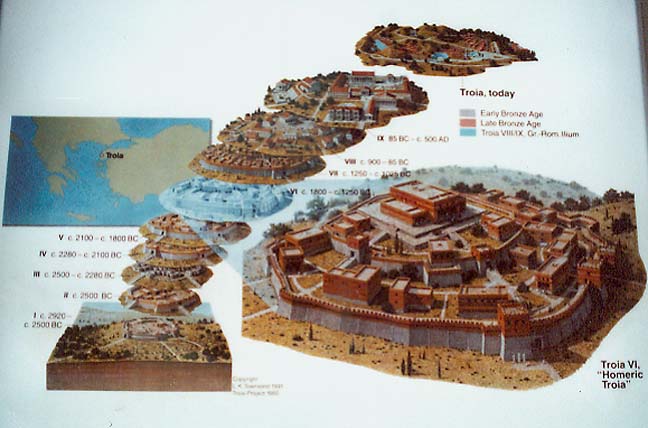
Troy (Asia Minor), also Ilium (ancient Ilion), famous city of Greek legend, on the northwestern corner of Asia Minor, in present-day Turkey. The legendary founder of the city was Ilus, the son of Tros, from whom the name Troy was derived. The son and successor of Ilus was Laomedon, who was slain by the hero Hercules, when Hercules captured the city. It was during the reign of Laomedon's son Priam that the famous Trojan War occurred, which resulted in the capture and destruction of the city.
The Troy that appears in the Homeric poems was long regarded as a purely legendary city, but in 1870 the German archaeologist Heinrich Schliemann began excavations that unearthed the actual stone walls and battlements of an ancient city on the mound called Hissarlik ("Place of Fortresses").
On the mound of Hissarlik, the following successive settlements have been determined:
Troy I - an early settlement with a wall built of small stones and clay, its date being perhaps about 3000 BC.
Troy II - a prehistoric fortress, with strong ramparts, a palace, and houses, dating from the 3rd millennium BC.
Troy III, IV, and V- prehistoric villages successively built on the debris of Troy II during the period from 2300 to 2000 BC.
Troy VI - a fortress, including a larger area than any of the preceding settlements, with huge walls, towers, gates, and houses dating from 1900 to 1300 BC or later.
Troy VIIA, a reconstruction of Troy VI - built in the later part of this period after the city had been destroyed by an earthquake.
Troy VIIB and VIII - Greek villages, of simple stone houses, dating from about 1100 BC to the 1st century BC.
Troy IX - the acropolis of the Greco-Roman city of Ilion, or New Ilion, with a temple of Athena, public buildings, and a large theater, and existing from the 1st century BC to about AD 500.